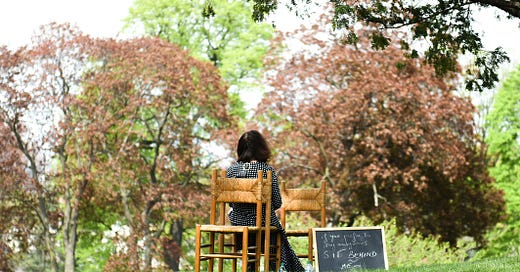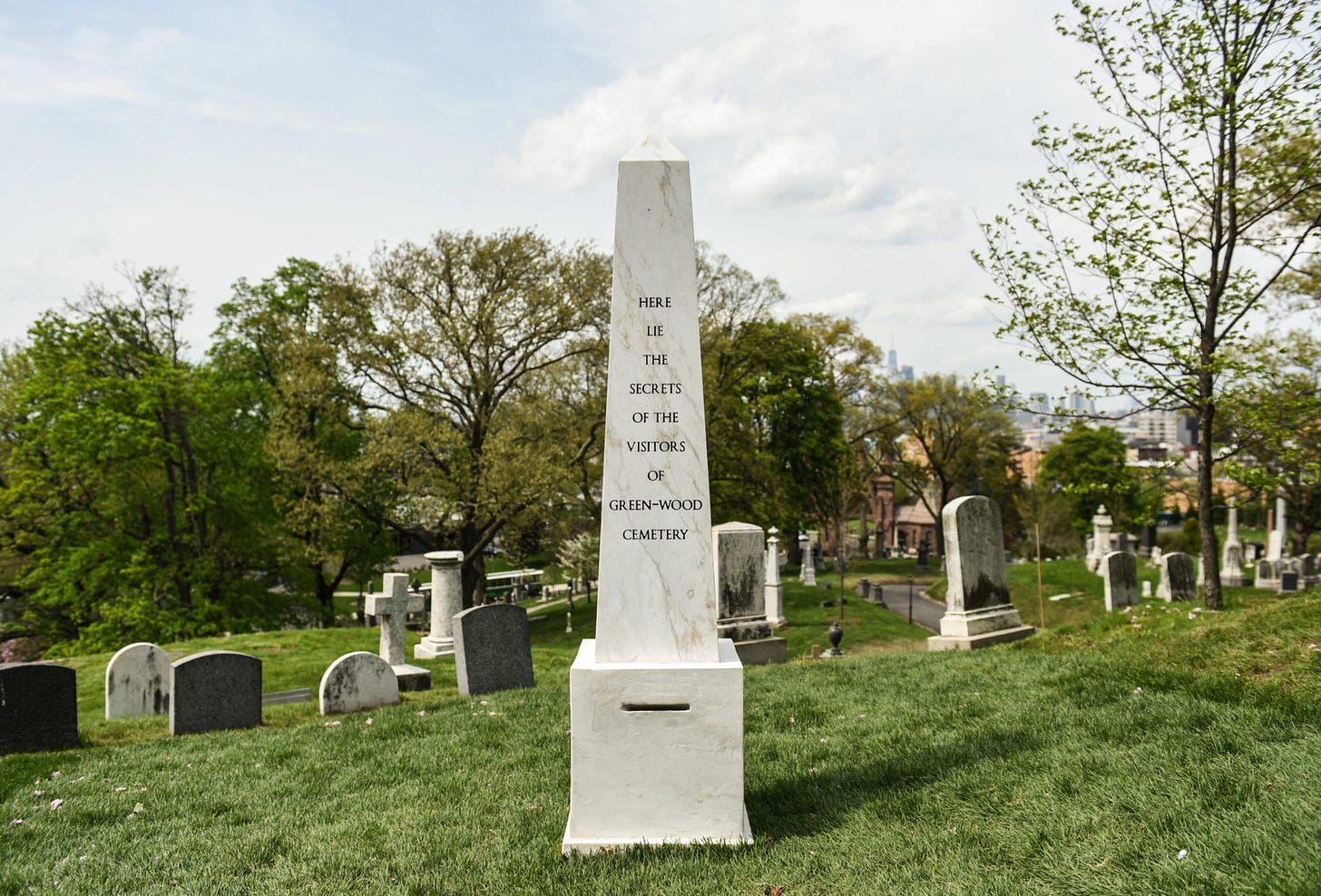Note: I was sick in bed for a week, so today I’m republishing a short thing that originally appeared in Sweet in 2017. Sweet is now defunct, so you won’t find this anywhere else.
Last Saturday, I went to a cemetery to share a secret with a stranger. So did, it seems, a few hundred other people. For a stranger, she’s quite well known. She’s Sophie Calle, an artist whose works are bound up in an intimate voyeurism, who once spent two weeks wearing disguises and following a man around Venice, who hired a private investigator to tail her through Paris, who invited 107 women to respond to a breakup email an ex-boyfriend had sent her and then exhibited those responses.
I was there to witness the inauguration of Calle’s latest project, Here Lie the Secrets of Green-Wood Cemetery. With the help of public arts organization Creative Time, Calle had an obelisk installed in the cemetery into which visitors can deposit cards containing their darkest (or silliest, or most trivial) secrets. Over the next 25 years, as the grave fills up, Calle will return to the Brooklyn cemetery, exhume all the slips of paper, and cremate them.
The idea was born from a devastating breakup, as so many strange ideas are. As Calle tells it in the project’s promotional materials, when a man she was in love with decided to end things, he told her an upsetting secret about himself, leaving her with some small power over him.
It was a beautiful afternoon to hang out among the dead, the warmest New York had had in months. Green-Wood itself is a special place, a who’s who of the city’s political and cultural history (e.g., “Boss” Tweed is buried there, if you’re into despotic New York business tycoons). On arriving, a Creative Time worker handed me a small envelope and a white card and directed me up a hill. There, a crowd of hopeful secret-tellers sat in the shade among headstones and tried to think of something worth sharing with a woman the New York Times once called “France’s most famous conceptual artist.” I wrote something on my card and tucked it in the envelope.
It’s not that, as a kid or a teen, I wasn’t good at keeping secrets. It’s that I never really wanted to keep them — which sounds a lot like I just wasn’t good at keeping them. Here’s the difference: Someone who is bad at keeping secrets is so frenzied and happy and overwhelmed with the trust placed in them that the secret becomes a burden too heavy to carry alone; they have to share it. But people like teen-me are social terrorists who generally consider most secrets to be boring and obvious and who know interesting things happen when low-grade secrets are whispered among friends.
Even now, I recognize there is some spectacle to sharing a secret. Indeed, it’s a spectacle everyone else in line waiting to meet with Calle also understood. Calle sat in a chair several yards away, her back to us. A spectator would sit in the chair facing her, tell her their secret, answer some questions, and then leave to drop their card in the obelisk. From the line, I watched each person’s face as they talked to the artist. Mostly people leaned in and smiled. They laughed or gestured as they spoke. One woman cried. But I could only see this. The conversations themselves were too faint to hear.
Sharing a secret with someone who is (relatively) famous is intimidating. Chloë Sevigny once told The New Yorker, “The coolest thing is to keep something to yourself.” All around me people were losing their cool in small but noticeable ways. A magazine editor ahead of me, as her time with Calle neared, pulled out a compact and swiped powder over her cheeks. A man turned to his friend and said, “I want to look pensive.” I ran through the contents of my secret in my head. I’d been waiting in line about an hour, anxious for my turn, when I suddenly asked myself, what if my secret wasn’t very… good?
It wasn’t. At least, I don’t think Calle was very impressed. I muttered hello to her as I sat down, and she responded only with a half-smile. Instead of simply talking to her as I’d seen others do, I pulled out my card and read the secret that was on it. She asked me two questions, one trying to clarify what I’d meant and another probing why I felt that this needed to be a secret at all.
“But isn’t this is something we all do?” she asked.
“Oh, maybe.” I said.
“Hmm.”
Then I stood up, unsure of whether she had just ended our conversation. She looked at me and said, “Oh?” as I waved goodbye.
Then I hurried to the obelisk, which was already so full of secrets that Creative Time had to put out a glass box to handle the overflow, and gave my card to another worker. Then I wandered, directionless, deeper into the cemetery.
Learn more about Calle’s project here.






